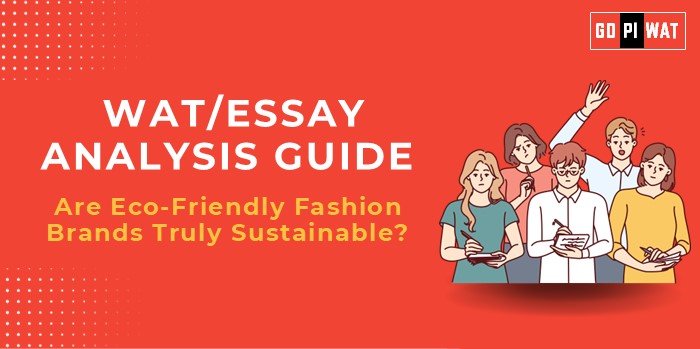📋 Written Ability Test (WAT)/Essay Analysis Guide: Are Eco-Friendly Fashion Brands Truly Sustainable?
🌍 Understanding the Topic’s Importance
This essay provides a platform to explore sustainability’s intersection with consumerism, economics, and global environmental challenges. It also aligns with themes like responsible business practices, innovation, and corporate ethics—key areas for B-school candidates.
⏳ Effective Planning and Writing
- 🧠 Time Allocation:
- Planning: 5 minutes
- Writing: 20 minutes
- Review: 5 minutes
- 📋 Preparation Tips:
- Gather key statistics and notable case studies.
- Identify stakeholders and their motivations.
📚 Structuring the Essay Body
- 🏆 Achievements:
- Highlight eco-friendly innovations like recycled materials and biodegradable fabrics.
- Discuss consumer shifts toward sustainability and regulatory advancements such as stricter labeling laws.
- ⚠️ Challenges:
- Greenwashing: Brands misleading consumers with false sustainability claims.
- Scalability: Difficulty in scaling sustainable practices globally.
- Global Disparities: Developing nations struggle with infrastructure and affordability.
- 🚀 Future Outlook:
- Propose solutions like government incentives to support sustainable businesses.
- Advocate for circular economy practices and technological innovations such as AI in material sourcing.
✍️ Sample Short Essays
- ⚖️ Balanced Perspective:
- 💡 Solution-Oriented:
- 🌏 Global Comparison:
“Eco-friendly fashion brands have made strides in reducing environmental impact through material innovation and recycling. However, challenges such as greenwashing and high costs question their overall sustainability. A collaborative approach, integrating regulations, technology, and consumer education, is crucial for achieving true impact.”
“To make sustainable fashion truly impactful, governments should enforce stricter greenwashing regulations, while brands invest in scalable and affordable eco-practices. Only then can eco-friendly fashion evolve from a niche movement to a global norm.”
“Sweden’s focus on recycling and education highlights how governments can drive sustainable fashion. Meanwhile, developing countries face cost and infrastructure challenges, underscoring the need for global cooperation in advancing eco-friendly practices.”


